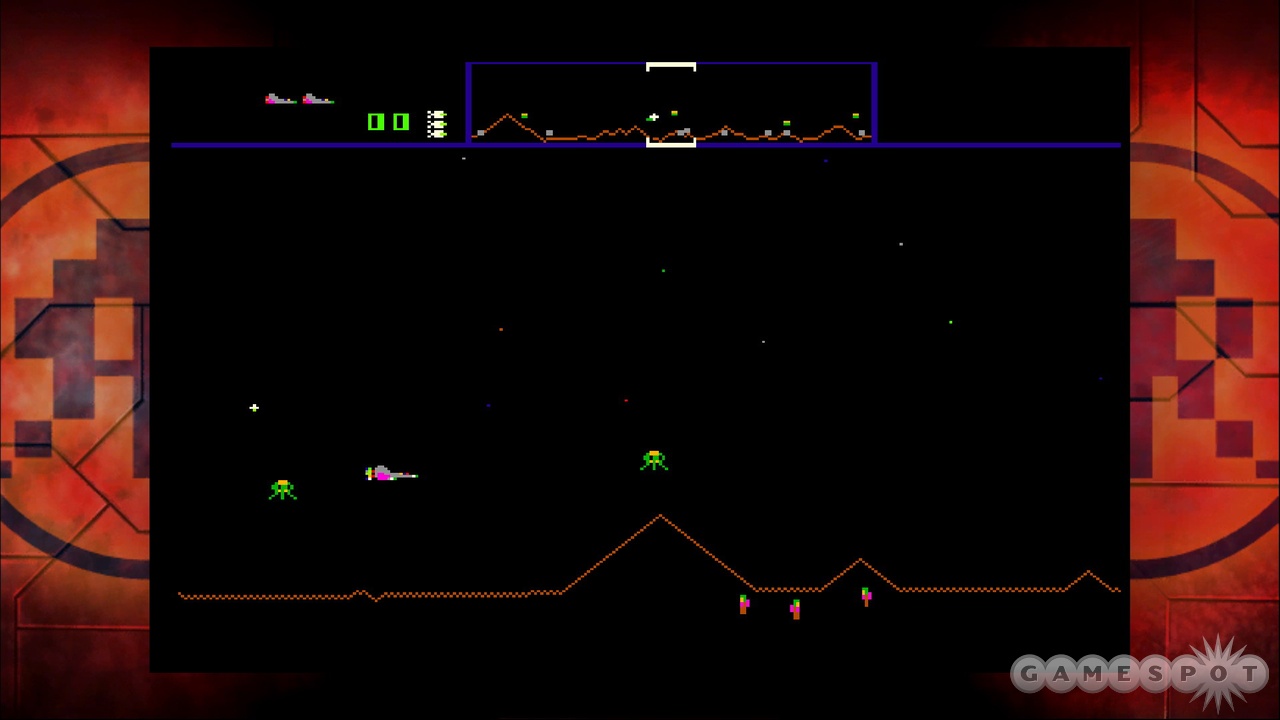Defender, originally released in arcades back in 1980, can be a hard, hard game. The arcade classic has you flying a ship above a planet, attempting to stop alien ships from abducting humans and combining with them to form deadly mutants. The Xbox Live Arcade version offers multiple control schemes, an online mode, and an alternate graphics mode. If you were a fan of the original game, chances are you'll enjoy this version.

Defender deals in waves. Each one of these waves gives you a pile of enemies to shoot at. When things get too heated, you can use a limited supply of screen-clearing smart bombs. You can also punch the hyperspace button, which warps you to a different random part of the level, but you often find yourself popping up in a more dangerous situation than the one you're trying to escape from. While there are various types of enemies flying around, you'll mainly want to concern yourself with the landers. These are the ships that try to kidnap the humans who roam the planet's surface. When they grab one, you'll hear a noise that lets you know that someone's in trouble. The landers then try to lift the human up to the top of the screen. If you get there in time, you can blast the lander, catch the now-falling human, and drop him safely back on the planet's surface. At the end of each wave, you receive bonus points for how many humans are left alive. You start out with 10, and every fifth wave replenishes your stock of people. If, at any point, all of the humans are dead, the planet explodes, and all the landers automatically become faster, more troublesome mutants. Defender was a hard game back in its day, and it's still tough, unless you resort to a trick or two that exploits the way the enemies behave.
The original Defender arcade cabinet had really complex controls for 1980. The joystick was more of a level that only moved your ship up and down. To thrust, you had a button, and a reverse button flipped your ship around so you could fly the other way. On the Xbox 360, the default scheme just lets you use the D pad or analog stick to fly around--pushing left flies left, right flies right, and there's no need to mess around with reverse buttons or thrust. But if you want to play that way, the triggers can be used for thrust and reverse. Either scheme works pretty well, so it's more a matter of preference.
In addition to being a good replica of the arcade version, there's also a pair of online modes in Defender, though maybe calling them "online" is a bit of a misnomer. When you play with another person, you can voice chat and see each other's scores, but you don't actually interact with the other player or see him or her playing the game. The difference between the two modes is that versus is a competition to get the highest score, while co-op combines the two scores. On top of that, the game ends when one player runs out of lives, making it possible to jump out ahead of the other player, then die on purpose quickly to win versus games. The two-player game, as it was in arcades, had the two players switching off. While that wouldn't be a very flashy addition, being able to play that way over Xbox Live seems as though it could have been sort of interesting. The achievements in Defender aren't impossible, but depending on your skills, some of them can be tough. Most of them are tied to finishing waves without losing humans, while one has you reaching specific levels and scores. Another asks you to survive for 75 seconds without attacking. That's tough unless you know what the "international date line" trick is, which refers to a set point to the left of the largest mountain that determines which way mutants and other enemies chase after you. By crossing this invisible line over and over again, you can keep the mutants changing directions and, ideally, never actually reaching you.

Graphically, Defender was technically impressive upon its release, because it took place on a scrolling screen on which you could scroll either left or right. To keep track of all that action, the game implemented a handy radar display at the top of the screen. Twenty-six years later, the game obviously looks less impressive, but this is still an accurate re-creation of the original game's graphics and sound. The game defaults to an updated graphical scheme that, much like many other Xbox Live Arcade arcade updates, redraws a lot of the graphics. The graphical update in this one is kind of ugly in spots, but the updated enemies look OK.
Like most of the other arcade classics hitting Xbox Live Arcade, this one is viewed best with a heavy dose of nostalgia. Defender is certainly a classic, but it doesn't hold up so well that you'd love it to death if you just started playing it today. But if you spent any serious time in arcades during the early- to mid-'80s, chances are there's a soft spot in your heart for Defender, and it's worth playing again.